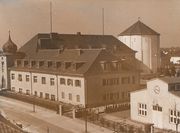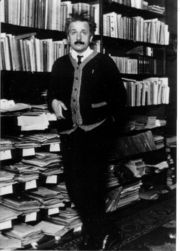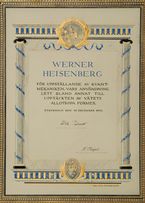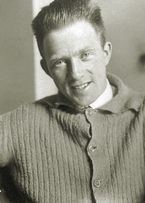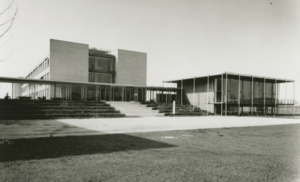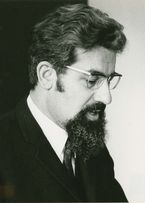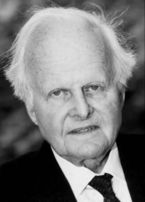A brief history of modern physics
Throughout the almost 100 years of its existence, the worldwide renown of the Max Planck Institute for Physics (Werner Heisenberg Institute) has been characterized by outstanding research findings. Hardly any other institute in Germany has hosted the work of so many famous scientists. Over the course of its history, the Institute has always been at the heart of modern research, not least because the principal founders of humankind’s understanding of modern physics have worked here.
The Max Planck Institute, which now makes its home in Munich, was founded in 1917 in Berlin as the Kaiser Wilhelm Institute for Physics. Its first Director was Albert Einstein. He headed the Institute until emigrating to the USA in 1933.
At the beginning of the 20th century, Einstein and his mentor, Max Planck, ushered in a new era of physics. Max Planck was awarded the Nobel Prize for Physics in 1918 for his works on quantum theory, Albert Einstein received the Nobel Prize in Physics in 1921 for his discovery of the law of the photoelectric effect. After World War II, the Kaiser Wilhelm Society was re-established and named for Max Planck.
In 1922, Max von Laue, also a Nobel Prize laureate in Physics (1914), became Deputy Director of the Institute. The Dutch physicist and 1936 Chemistry Nobel Laureate, Peter Debye, headed the Institute after Einstein left. In 1938, i.e. ten years before the foundation of the Max Planck Society, the Institute was already given the additional name “Max Planck Institute”. An agreement between the American Rockefeller Foundation and the Third Reich made it possible to fund a building for the Institute in Berlin.
Second World War
After the outbreak of World War II, German military authorities began to set up a secret “uranium project” at the Berlin-based Institute in 1939. By the end of the war it was on the verge of bringing the first nuclear reactor into its critical state. As the physicists could not meet the deadlines of the armaments minister, the uranium project was returned to civil administration in 1942.
July of the same year also saw Werner Heisenberg appointed Director of the Institute in Berlin. Heisenberg was at least as influential on the development of modern physics as his famous predecessors. He is considered to be one of the fathers of quantum mechanics – the theory that describes how molecules, atoms, atomic nuclei and the elementary particles behave. In 1933, he had been presented with the 1932 Nobel Prize for this work.
As early as 1946, i.e. shortly after the end of the war, the British occupation authorities allowed German physicists to re-open their Institute as the Max Planck Institute for Physics – not in Berlin, but in the town which had been the center of physics in the years before 1933, in Göttingen. The Director was again Werner Heisenberg, who expanded the Institute together with Deputy Director Max von Laue initially, and with old as well as new members of staff.
The MPP in Munich
In 1958, the Institute moved to Munich as the Max Planck Institute for Physics and Astrophysics under Directors Heisenberg and Biermann. The well-known architect Sep Ruf designed the new Institute building in Munich-Freimann. Heisenberg’s time as Director saw the founding of the Institute for Plasma Physics in Garching in 1960.
In taking this step, the scientific management headed by Heisenberg took into account the increasing demand for new energy sources in Germany. Today, the MPI for Plasma Physics - which became an independent Institute in 1971 - is considered to be one of the world’s leading research centers working on the development of a fusion reactor. After Heisenberg’s death in 1976, the Max Planck Institute for Physics was given the additional name “Werner Heisenberg Institute” in his honor.
In 1947, Ludwig Biermann oversaw the establishment of an Astrophysics Department in Göttingen. Biermann’s discoveries included the solar wind, a stream of particle from the Sun which makes itself felt on Earth through the polar lights and radio interferences. He became a household name thanks primarily to his work on space travel. Over the course of its history, Biermann’s Astrophysics Department has evolved into today’s Max Planck Institute for Astrophysics. In 1963, the sub-Institute for Extraterrestrial Physics was founded in Garching.
Famous physicists shape the Institute’s history
Prominent researchers who worked at the Max Planck Institute for Physics also include the physicist and philosopher Carl Friedrich von Weizsäcker. As one of Heisenberg’s students and as a scientist, he made important contributions to nuclear physics, energy generation by means of nuclear fusion in stars, and the theory of planet formation.
As a philosopher, he focused public attention on the importance of modern natural sciences and the consequences of nuclear physics for mankind’s understanding of the world. His work led to the establishment of a Max Planck Institute for Research on the Living Conditions in the Scientific and Technical World in 1970. This Sub-Institute was closed again in 1980 when its Director retired.
Hans-Peter Dürr, who had worked closely with Heisenberg, succeeded him as head of the Institute until the end of 1971. He is seen as a pioneer of the peace and environmental movement far beyond Germany’s borders. Early in his career, he gained widespread attention with his statements on nuclear energy and disarmament issues. In 1987, his commitment earned him the alternative Nobel Prize presented by the Swedish philanthropist Jakob von Uexküll.
Spin-offs and new Institutes
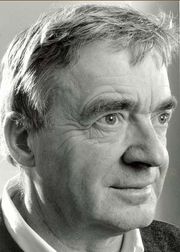
The MPI of Quantum Optics in Garching was established in 1987, heralding in an era characterized by several spin-offs and new Institutes. 1991 saw the Sub-Institutes for Astrophysics and for Extraterrestrial Physics become Institutes in their own right. The management of the Max Planck Institute for Extraterrestrial Physics was taken over by Reimar Lüst, who later became President of the Max Planck Society.
In 1992, the two Max Planck Institutes for Physics and for Extraterrestrial Physics set up a joint semiconductor laboratory. Today’s Max Planck Semiconductor Laboratory develops detectors for particle physics and astronomy. Since 1993, the MPI for Physics has had a further “Satellite Institute”: the Max Planck Institute for Gravitational Physics in Potsdam.
Julius Wess, who was appointed to the Max Planck Institute for Physics in 1990, is undoubtedly one of the most outstanding researchers of the last 50 years. With the establishment of supersymmetry, he created a pioneering model for elementary particle physics which has occupied whole generations of researchers. Wess was awarded the Wigner Medal for his research achievements in 1992. Today, the experiments at the LHC, the international particle accelerator at CERN, are endeavoring to track down supersymmetric particles as predicted by the theory advanced by Wess and his colleague and friend, Bruno Zumino.
The Excellence Initiative
In 2005, the German Research Foundation (DFG) together with the Science Council established the Excellence Initiative in order to promote cutting edge research in Germany. The MPI for Physics is a member of the “Origin and Structure of the Universe” Cluster of Excellence which is funded by the DFG and was established in 2006 at the TU Munich. Today, the institute is active in the succeeding project ORIGINS.
The 200 or so physicists from different disciplines who are working on this project are searching for answers as to how the universe was formed. The MPP thus highlights its efforts to pursue topical and relevant issues of physics in interdisciplinary projects, which fits with the Institute’s outstanding importance in the German research landscape. In November 2012, the funding of the Cluster was extended by a further five years.
Discovery of the Higgs particle
In July 2012, physicists at CERN announced the discovery of a new particle. It is very likely that the particle found is the last building block of the Standard Model of particle physics: the Higgs boson, which is thought to be responsible for the mass of all particles. Researchers from the Max Planck Institute for Physics headed by Director Siegfried Bethke played a crucial role in the discovery of the particle with the <link forschung physik-mit-beschleunigern atlas-detektor external-link-new-window internen link im aktuellen>ATLAS experiment.
